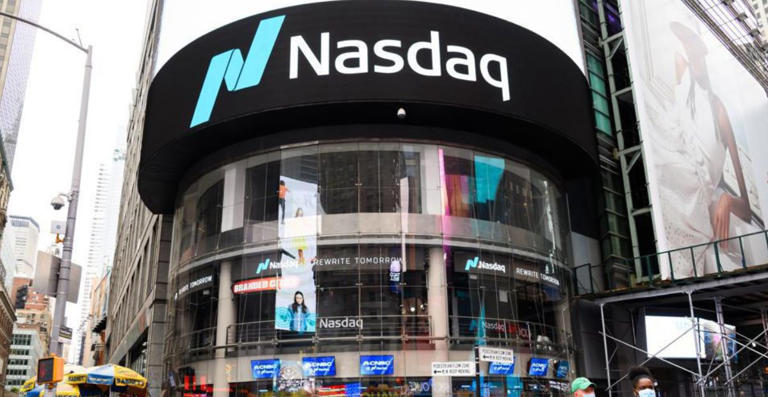On Thursday, March 8th, 2024, the US stock market experienced a notable upswing, marked by major indices closing higher and setting new records. The Dow Jones Industrial Average saw an increase of 130.30 points, or 0.34%, ending the day at 38,791.35.
Similarly, the S&P 500 displayed a strong performance, surging by 52.60 points, or 1.03%, to reach a record high of 5,157.36. The Nasdaq Composite also achieved an intraday record high, closing 241.83 points, or 1.51%, higher at 16,273.38.
These significant gains reflect a buoyant market atmosphere, characterized by increased investor confidence and optimism. The surge in stock prices indicates a positive shift in market dynamics, with various factors contributing to the upward trajectory.
Why the Surge?
The recent surge in the stock market can be largely attributed to the remarks made by Federal Reserve Chair Jerome Powell during his testimony before a US Senate committee.
Powell indicated that the central bank is nearing a level of confidence regarding inflation, suggesting that rate cuts could become more likely in the near future.
This insight, as reported by Reuters, has instilled a renewed sense of optimism in the market, with investors interpreting it as a signal for potential rate cuts as early as June. Powell’s statements have had a significant impact on market sentiment, with his reassurance about the Federal Reserve’s vigilance regarding inflation and readiness to implement rate cuts resonating positively among investors.
The anticipation of these rate cuts has not only bolstered market confidence but has also served as a driving force behind the impressive gains observed in the days following Powell’s Congressional testimonies.
When Did This Happen?
The market surge occurred on Thursday, following Jerome Powell’s appearances before the US House Financial Services Committee, which began on Wednesday.
Powell’s optimistic assessment of declining inflation and the potential for rate cuts resonated with investor expectations.
The timing of this surge, coming after Powell’s testimonies, underscores the immediate and significant influence that central bank communications can have on market dynamics.
Powell’s appearances before Congress were pivotal, impacting trading decisions and shaping investor sentiment. The importance of these events in influencing the timing and nature of market movements cannot be overstated.
What Sectors Drove the Rally & Which Companies Stood Out?
A significant contributor to the market rally was the notable surge in chip companies, driving the Philadelphia Semiconductor Index to a record closing high, increasing by 3.36%.
Within the S&P 500 sectors, Technology emerged as the top performer with a gain of 1.89%, closely followed by communications services, which saw a 1.84% increase.
Individual stock performances during the surge varied widely. Meta shares, for example, experienced a rise of 3.2%, reflecting positive sentiment surrounding the company. Similarly, Nvidia, a prominent player in the tech sector, witnessed an impressive 4.5% increase in its stock price. These individual success stories highlight the influence of specific companies on overall market performance.
However, Victoria’s Secret & Co. shares suffered a sharp decline of 29.7%, raising concerns about the challenges faced by certain companies in the current economic environment.
Conversely, Kroger Co. shares rallied significantly by 9.8%, showcasing the resilience and adaptability of certain sectors amidst market fluctuations.
How Did Other Indicators Fare?
On the Nasdaq, the market breadth was evident, with 2,592 stocks rising and 1,670 falling, indicating a favorable ratio of advancing issues to decliners.
Data from the Labor Department, as reported by Reuters, indicated that the number of Americans filing new claims for unemployment benefits remained unchanged. Additional insights into the job market were provided through private payrolls, job openings, quit rates, and unemployment claims data. Collectively, these indicators depicted a job market that, while displaying signs of softening, remains fundamentally robust.
On US exchanges, 11.19 billion shares changed hands during the surge, slightly below the 12.06 billion moving average for the last 20 sessions. This information offers insight into the level of market participation and the intensity of trading during this bullish phase.
The slightly lower trading volume, though still substantial, warrants further examination of investor behavior and the factors influencing trading activity.
Any Insights into Market Activity?
Indeed, the trading of 11.19 billion shares on US exchanges, though slightly below the 12.06 billion moving average, still signifies a notable level of market participation.
Economic indicators like unemployment claims and private payrolls offer further depth to our understanding of the broader economic environment.
The unchanged number of Americans filing new claims for unemployment benefits, as reported by the Labor Department, suggests a labor market that, while evolving, maintains stability.
This comprehensive analysis furnishes investors, analysts, and stakeholders with a detailed perspective on the factors contributing to the surge and the complex interplay of elements shaping market dynamics.
